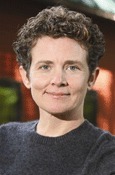When Robyn Scott was seven years old, her family swapped a tranquil existence in New Zealand for an adventurous new life in Botswana.Twenty Chickens for a Saddle is Scott's beautifully written portrait of her idyllic childhood there. A graduate of Cambridge University, she lives in London but works and travels frequently in Africa.
"What does your family think?"
This question is the unchallenged front-runner among those I've been asked about Twenty Chickens for a Saddle, the story of my childhood in Botswana. It is also the second question I put to myself when I set about writing, and one that I have asked my family and myself repeatedly ever since. The answers, unsurprisingly, have been varied and evolving, and, while never disapproving, thankfully became more positive as the initial clumsy pages slowly metamorphosed into a respectable book.
That is, except in one case: one that illuminates the heart of the challenges for me in writing this story.
My literary agent, meeting my maternal grandparents a few months ago, had posed the well-worn question. We were having sundowners – whiskies, brandies and salted peanuts – which, but for the lush backdrop of a Cape Town garden, were straight out of the now faraway world of the book. "It's a decent read," replied my grandfather. "And quite nicely written," he added. Then he frowned, almost accusingly. "But maybe now you can explain to me what on earth the fuss is about? Why would anyone care what we all got up to in a little town in Botswana?"
This had been the first question I asked myself two years earlier, when it was suggested I should write a book. "No one would," I'd told myself. The conclusion was persistent: When, after a few months of others' encouragement, I dusted off the idea and wrote a hesitant first few thousand words, I reviewed them with dismay.
I had begun – unimaginatively – with my first day in Botswana, when I met both the country and my paternal grandfather; and when, in the gathering darkness, two brown fruit moths fluttered down and sipped red wine-laced grape juice from the corners of my grandfather's lips. The memory was vivid and magical. But in the unforgiving light of the morning after words met page, it seemed suddenly indulgent: Two moths? Who cares? The magic was in being there as a little girl . . . magical only to me.
Snakes, I decided: safely, objectively, indisputably exciting.
I rewrote the beginning, featuring a large, poisonous, ultimately disembowelled puff adder in the first few paragraphs, relegating the humble moths deep into the story. Increasingly confident, I proceeded over the next weeks to describe – littering adverbs and adjectives – the black mamba that had dangled menacingly over my shocked father from a shower head; the heart-stopping evening my little sister had heroically chased another (even bigger!) black mamba poised to fatally strike our tiny terrier; a burly, scarred friend of ours who'd bravely broken a crocodile's jaw; several swashbuckling snake-lion-mortal-danger stories from my wild grandfather's early days in the wilds of Botswana.
I soon ran out. And after four frustrating discussions with my parents and siblings, I had just a couple more. Beyond these, the dinner party hits, nothing. Think harder, I pleaded. By then putting together a proposal, I was becoming concerned that even if an agent liked the idea I might nevertheless, horribly, find myself with nothing more to say.
My agent, David Godwin – now eyed quizzically over a crystal whisky glass – had liked the idea. "But the book came alive for me with the moths," he'd said to my astonishment. "You should begin with the moths." And so began for me the delightful process of discovering how the quieter, character-rich moments, hovering discreetly in the shadows of grander memories, often most comfortably inhabit the page. And in evoking these, began in each of us a gathering snowball of recollections.
The recollections came, naturally, in varying shades. But when I showed the first draft to my family, all but two differences were quickly resolved. My father disputed that he and his father stopped talking to each other. "He stopped talking to me," he maintained. My mother disputed a description of the mechanism of a catapult built to stun geckos, to scare them into dropping their tails, to feed to the pet snakes in our schoolroom. On both, I stood my ground.
Hours before the deadline for the final draft, my mother was helping me do a last frantic fact check. I walked into the lounge to find her perched on the sofa, surrounded by hundreds of pages – several including arguably less-than-flattering descriptions of her. In her hand was a wooden ruler, pierced with a drawing pin, almost a la the catapult. Seeing me, she smiled, pointed it at the bookcase, and released a rubber band stretched along its length. The band flew wildly off course. "See," she said triumphantly.
The moths begin the book. Of the early stories, the puff adder alone is found in its pages. The catapult mechanism remains unresolved. We are all still talking to each other.

























